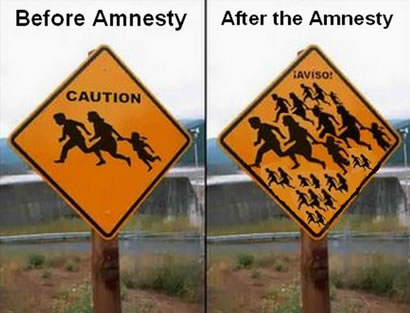From the front page of the New York Times three years after the “one time” amnesty: 1986 AMNESTY LAW IS SEEN AS FAILING TO SLOW ALIEN TIDE
See the article in its original context from
June 18, 1989, Section 1, Page 1Buy Reprints
New York Times subscribers* enjoy full access to TimesMachine—view over 150 years of New York Times journalism, as it originally appeared.
SUBSCRIBE
Doris Meissner, an expert on immigration for the Carnegie Endowment, a Washington research organization, said, ”There is evidence that many potential immigrants waited for a while to see how the law worked and have since begun moving again. If so, we should see the flow across the border accelerating any day.” A Magnet of Sorts
The 1986 law allowed 3.1 million previously illegal aliens to obtain legal status here. Recent studies show that many thousands of people crossed the border surreptitiously to take advantage of the program, some of them with falsified documents and personal histories. The mass of newly legalized immigrants is also acting as a magnet for illegal aliens who want to come to the United States to join friends and relatives.
New York Times
June 18, 1989
By Roberto Suro, Special To the New York Times
1986 AMNESTY LAW IS SEEN AS FAILING TO SLOW ALIEN TIDE
The most sweeping effort to halt illegal immigration in American history, the 1986 overhaul of immigration law, may have cut the flow of illegal aliens less than expected and may have actually encouraged unlawful entry in several ways.
Two years after it began to take effect, experts around the country are starting to draw conclusions about the law’s effect. As thousands of people continue to enter the country illegally every day, the first arguments are being entered in a debate over whether the legislation has achieved its goals, and whether it ever will.
Some in Congress seek more effective enforcement of the law; others want to focus on the poverty and turmoil in the third world that force people out of their homelands. Meanwhile, the Immigration and Naturalization Service has proclaimed the law a clear success, and the Bush Administration has yet to put its own stamp on immigration policy.
”We have found no evidence that the 1986 immigration law has shut off the flow of new undocumented migrants,” said Wayne Cornelius, director of the Center for U.S.-Mexican Studies at the University of California at San Diego. A Decade of Study
The Immigration Reform and Control Act of 1986, whose measures began to take effect in May 1987, was the first nationwide response to a wave of illegal immigration that began in the mid-1960’s and created a resident population of illegal aliens variously estimated between 6 million and 12 million people.
After a decade of study and argument in Washington, the 1986 law emerged as a mixture of humanitarian and restrictive measures. Unlike the two previous efforts to counter similar waves of illegal immigration in the 1930’s and 1950’s, there was no resort to mass deportations. The law offered legal status to illegal aliens who had lived in the United States continuously since Jan. 1, 1982, and it imposed penalties on employers who knowingly hired illegal aliens. It also allowed migrant workers to enter the United States during harvest season.”The legislation bought time for everyone and made the problem more manageable for a while,” said Leonel J. Castillo, who was Commissioner of Immigration and
Naturalization during the Carter Administration and is now president of Houston International University. ”It seems, however, that time has passed more quickly than expected, and so it is important to see where we stand, because I think we will be dealing with the issue again soon.” Torrents of People
According to indicators used by the immigration service to estimate traffic across the southern border, this year there will be 1.7 million to 2.5 million crossings. The most recent statistics signal that the flow may have increased in April and May.
Separate surveys of illegal aliens conducted by researchers based in Mexico, Texas and California all found that immigration by first-time travelers, as against those who had previously been to the United States, has been on the rise for at least a year. Experts also agree that the flow had dropped off through most of 1987. As a result, immigration experts say they have identified a ”wait and see” response to the law among potential immigrants that may be producing a new wave of illegal immigration…



